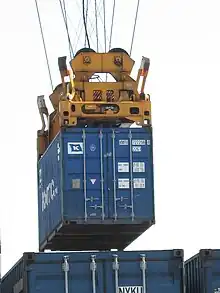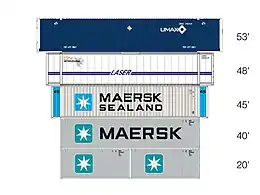ISO 668
ISO 668 - Series 1 freight containers — Classification, dimensions and ratings is an ISO international standard which classifies intermodal freight shipping containers nominally, and standardizes their sizes, measurements and weight specifications.[1]
| Series 1 freight containers — Classification, dimensions and ratings | |
 | |
| Abbreviation | ISO 668:2020 |
|---|---|
| Latest version | 7 668:2020 |
| Preview version | Sixth edition 2013-08-01 |
| Organization | International Organization for Standardization |
| Committee | Technical Committee ISO/TC 104: Freight containers, Subcommittee SC 1: General purpose containers |
The current version of the standard is the Seventh edition (2020), which integrates version E. The standard was prepared by Technical Committee ISO/TC 104: Freight containers, Subcommittee SC 1: General purpose containers.[2]
Introduced in 1968, ISO 668 currently regulates both external and internal dimensions of containers, as well as the minimum door opening sizes, where applicable. Minimum internal dimensions were earlier defined by ISO standard 1894: 'General purpose series 1 freight containers – Minimum internal dimensions'.[3] Its second edition appeared in 1979, but was withdrawn, once revised by ISO 1496‑1 of 1990.[4] ISO 1496‑1's current version is 2013, including Amendment 1 of 2016,[5] last reviewed and reconfirmed in 2019.[6]
ISO 668 also specifies the respective associated gross weight ratings, and includes requirements for load transfer areas in the base structures of containers, since Amendment 1 of 2005.[7]
Amendment 2 of 2005 further added forty-five foot length containers to the standard.[7]
The maximum gross mass (MGM) rating of twenty- and thirty-foot length units was notably increased to 30,480 kg (67,200 lbs) by Amendment 1 of 2005.[7] Until then, the MGM for 20-foot units was 24,000 kg (52,900 lbs), and for 30-foot boxes 25,400 kg (56,000 lbs). However, since Amendment 2 of 2016, the maximum gross mass for ISO-standard Series 1 containers of all sizes, (except 10‑foot units), has most recently been further increased to a maximum of 36,000 kg (79,370 lbs).[8] Draft Amendment 1 of ISO 668: 2020 – for the eighth edition – maintains this.[9]
A separate standard is set for the required stacking strength, or 'maximum superimposed mass' (MSM) for standard containers. The ISO standard for Series 1 containers, ISO 1496‑1, established this, among other characteristics, for many years set at 192,000 kg (423,290 lbs).[10] However, in order to keep pace with the increase of container maximum gross weight, the continuing growth of container-ships size, and the related height of container stacks on board the ships, the required stacking strength was increased to a superimposed weight of 213,360 kg in 2005 per Amendment 3.[8] This value was since maintained in the latest revision of Standard 1496‑1 (2013). Production statistics show that the vast majority of containers have, for many years, been built with a stacking strength at or above the 213,000 kg figure stipulated in ISO 1496‑1. In fact, most major container operators and lessors now cause containers to be built above the required figure, with the most common superimposed strength being 216,000 kg.[8]
Scope and systematic structure

The ISO 668 standard firstly classifies containers by their length in whole (imperial) feet for their 'common names', despite all measurement units used being either metric (SI), or officially based on the metric system. The exact standard length of '30-foot' and shorter containers is actually slightly shorter than their nominal length, to accommodate for the space taken up by twist-lock couplers, required for stacking containers of unequal length.
Stacking
ISO containers up to 40‑foot in length are only required to have stacking strength at their four corners – typically achieved through four strong, vertical (steel) corner posts. Shorter than 40‑foot containers must therefore be horizontally joined together rigidly (with four twist-locks between every two containers), to form a rigid combined whole of matching length to longer containers[Note 1] (both underneath and above them), to be stackable – supported on the four outside corners of any resulting combination.
ISO standard 668 hence defines the exact lengths of all standard container sizes on purpose in such a way that shorter containers, joined with the also standard sized twistlocks, can always form longer, combined units of an exact length, identical to that of longer containers, or other combinations, such that the corner castings will always line up on top of the four outside corners of another, longer container, or combination, for vertical connecting and securing.
However, this does not apply when stacking 40‑foot and 45‑foot containers in one stack. These can be stacked interchangeably. ISO standards require 45‑foot containers to include a second set of four strong vertical columns (like corner posts), manufactured in them, symmetrically at the 40‑foot length position (meaning 2+1⁄2 ft (76 cm) inwards from their actual outside corners), to support being stacked interchangeably with 40‑foot containers.
ISO designations
| ISO designation * | Common Name | External dimensions | Minimum internal dimensions ** | Maximum Gross Mass | ||||
|---|---|---|---|---|---|---|---|---|
| Length | Height | Width | Length | Height | Width | |||
| 1EEE *** | 45 foot high cube | 45 ft / 13.716 m |
9' 6" / 2.896 m |
8 ft / 2.438 m |
13.542 m / 44' 5.15" |
2.655 m / 8' 8.5" |
2.330 m / 7' 7.73" |
36,000 kg **** / 79,370 lbs |
| 1EE *** | 45 foot standard | 8' 6" / 2.591 m |
2.350 m / 7' 8.5" | |||||
| 1AAA | 40 foot high cube | 40 ft / 12.192 m |
9' 6" / 2.896 m |
8 ft / 2.438 m |
11.998 m / 39' 4.375" |
2.655 m / 8' 8.5" |
2.330 m / 7' 7.73" |
36,000 kg **** / 79,370 lbs |
| 1AA | 40 foot standard | 8' 6" / 2.591 m |
2.350 m / 7' 8.5" | |||||
| 1A | 40 foot | 8 ft / 2.438 m |
2.197 m / 7' 2.5" | |||||
| 1BBB | 30 foot high cube | 29' 11.25" / 9.125 m |
9' 6" / 2.896 m |
8.931 m / 29' 3.6" |
2.655 m / 8' 8.5" |
36,000 kg **** / 79,370 lbs | ||
| 1BB | 30 foot standard | 8' 6" / 2.591 m |
2.350 m / 7' 8.5" | |||||
| 1B | 30 foot | 8 ft / 2.438 m |
2.197 m / 7' 2.5" | |||||
| 1CCC | 20 foot High Cube | 19' 10.5" / 6.058 m |
9' 6" / 2.896 m |
5.867 m / 19' 3" |
2.655 m / 8' 8.5" | |||
| 1CC | 20 foot standard | 8' 6" / 2.591 m |
2.350 m / 7' 8.5" | |||||
| 1C | 20 foot | 8 ft / 2.438 m |
2.197 m / 7' 2.5" | |||||
| 1D | 10 foot | 9' 9.75" / 2.991 m |
8 ft / 2.438 m |
2.802 m / 9' 2.3" |
2.197 m / 7' 2.5" |
10,160 kg / 22,400 lbs | ||
| 1E ***** | 6½ foot | 6' 5.5" / 1.968 m |
8 ft / 2.438 m |
8 ft / 2.438 m |
1.778 m / 5' 10" |
2.197 m / 7' 2.5" |
2.330 m / 7' 7.73" |
7,110 kg / 15,700 lbs |
| 1F ***** | 5 foot | 4' 9.5" / 1.460 m |
8 ft / 2.438 m |
1.270 m / 4' 2" |
5,080 kg / 11,200 lbs | |||
| * The standard also recognises containers under 8 feet in height, designated as 1AX, 1BX, 1CX and 1DX, with specifications the same as other containers of their length.
** Minimum internal dimensions were previously defined by ISO standard 1894: 'General purpose series 1 freight containers – Minimum internal dimensions' (2nd edition; 1979) [3] | ||||||||
| *** Forty-five foot containers were added to the standard per Amendment 2 of 2005.[7] | ||||||||
| **** The maximum gross mass rating of standard containers of all sizes (except 10-ft length) was increased from 30,480 kg (67,200 lbs) to 36,000 kg **** (79,370 lbs), per Amendment 2 to ISO 668 (in 2016).[9][8]
The maximum gross mass rating of twenty and thirty foot units was earlier uprated with Amendment 1 of 2005.[7] Until then, the MGW for 20-ft units was 24,000 kg / 52,900 lbs, and for 30-ft units 25,400 kg / 56,000 lbs. | ||||||||
| ***** Six and a half and five foot containers (type 1E and 1F) are not in the current edition ISO 668 standard, but were standardised in previous editions,[11] and are still made.[12][Note 2] The so-called width of these small-size containers may be perceived as their length, as it is their greatest horizontal dimension, and their doors are frequently in the short end(s). | ||||||||
See also
- ISO 6346 — standard covering the coding, identification and marking of intermodal containers
Notes
- or another same-length joined container-combination
- The U.S. Army uses these under the names of 'tricons' and 'quadcons' respectively.
References
- "ISO 668:2020 - Series 1 freight containers -- Classification, dimensions and ratings". www.iso.org.
- ISO std. 668:2020 – Series 1 freight containers — Classification, dimensions and ratings | Amendment 1 (preview)
- Technical Specification for a Typical Steel Dry Cargo Container; 20' x 8' x 8'6" ISO 1CC Type "General Purpose" (PDF). Steinecker Containerhandel. December 2012. p. 2. Retrieved 16 September 2021.
- ISO 1894:1979, Withdrawal - ISO.org (archived)
- ISO 1496‑1:2013 Amendment 1 (2016) – Series 1 freight containers; Specification and testing – Part 1 General purpose cargo containers – ISO (archived)
- ISO 1496‑1:2013 - Series 1 freight containers; Specification and testing – Part 1 General purpose cargo containers – ISO (archived)
- ISO 668:1995 Series 1 freight containers — Classification, dimensions and ratings — Amendment 1 & 2 (Technical report). ISO. 2005-10-01.
- Sub-committee on Carriage of Cargoes and Containers (5 July 2019). Discrepancy in container stacking strength requirements between the pertinent ISO Standard and the Convention for Safe Containers (CSC) (PDF) (6th session; Agenda item 13 ed.). International Maritime Organization. pp. 1–2. Archived (PDF) from the original on 2021-09-16. Retrieved 16 September 2021.
- Draft Amendment ISO 668:2020/DAM 1
- ISO 1496‑1:1990, Preceded by Amendments 1:1993, and 2:1998
- "Container Handbook - Section 3.2 Container dimensions and weights". www.containerhandbuch.de.
- "Archived copy" (PDF). Archived from the original (PDF) on 2019-08-09. Retrieved 2015-07-25.
{{cite web}}: CS1 maint: archived copy as title (link)
External links
- ISO 668:2005(E) Amendments 1 & 2 to ISO 668:1995 (attached)
- ISO 668:2013(E) Sixth edition — (pdf; archived)
- Draft amendment of eighth edition — (pdf; archived) including preview of Seventh edition ISO 668: 2020
- ISO Technical committee TC104: Freight containers